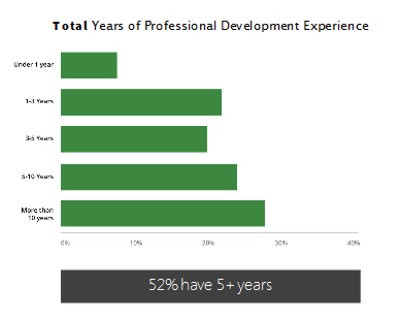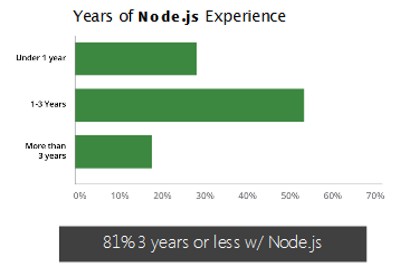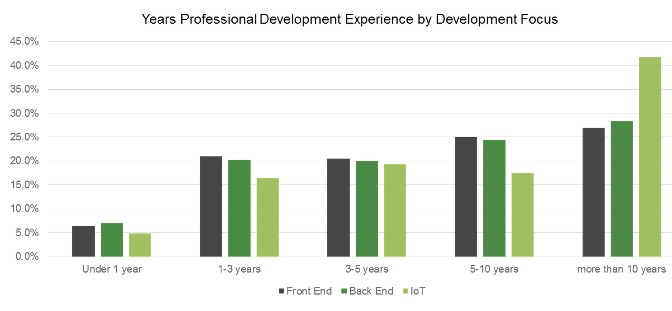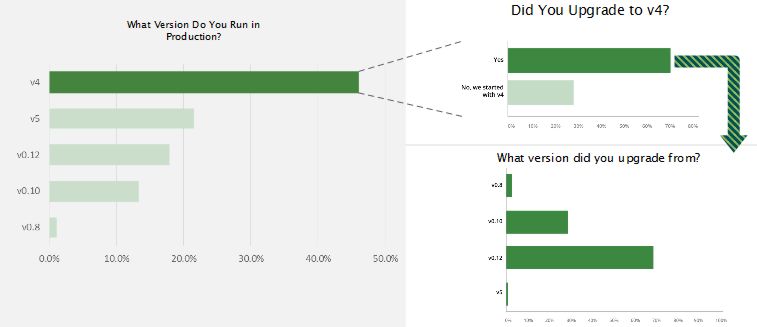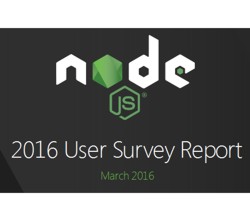| Node.js Foundation Survey |
| Written by Janet Swift | |||
| Tuesday, 12 April 2016 | |||
|
The Node.js Foundation has released its first Node.js User Survey Report. It reveals that Node.js is emerging as an universal platform/language used for web applications, IoT, and enterprise. The survey was conducted in January 2016 and was completed by 1,760 people around the world, 64% of whom run Node.js in production. Around 70% of respondents were developers and 22% technical management. Around 15% of all respondents work within large enterprises. Over half of developers responding to the survey had 5 or more years general professional development experience but fewer than 20% had more than 3 years experience of Node.js:
A key finding of the report is that: The full stack is no longer “front end and back end,” but rather “front end, back end and connected devices,” which is a combination of everything from the browser to your toaster all being run in JavaScript and enabled by Node.js. Over 90% of the developers in the survey selected Web Apps as the work they spent most time on and around a third of them were Hobbyists. Of the 824 developers who run Node.js in production, 62% do both Front End and Back End development and 9% do Front End,Back End and IoT development. Those engaged in IoT stand out from the crowd with the report finding: on average, IoT developers using Node.js have more experience than their front end and back end counterparts with over 40% percent of IoT developers surveyed having over 10+ years of development experience.
(click in graph to expand) The survey looked at the popularity of languages other than Node.js/JavaScript finding that PHP was the most popular for all three groups. Java took second place for Back End and Front End devs while Python was runner up for those involved with IoT and and Java. However, when looking to the all group planned to decrease their use of Java, .Net and PHP and increase the use of Python and C++.
(click in graph to expand) One aim of the survey was to discover what other technologies are used with Node.js and a key finding highlighted by Node.js Foundation is that: Node.js and containers take off together Being more specific Docker is used by 58 percent of respondents involved with IoT, by 39 percent of Back End and 37 percent of Front End developers. Another finding relates to the popularity of the MEAN stack: The popularity of real-time, social networking and interactive game applications is pushing a new stack among developers. The MEAN stack is able to handle lots of concurrent connections and extreme scalability, which these applications demand. Node.js, in combination with MongoDB, Express, Angular.js, allows developers to tackle the needs of front end and back end development. Not surprisingly, all of these technologies were commonly used alongside Node.js. Express, cited the most, used by an average of 83% of developers. Also of obvious interest for the Node.js Foundation is the adoption of the Node.js Long Term Support release (v4) geared toward medium to large enterprise users who require stability and high performance.
As these two charts reveal, more than 45 percent are already using v4 and of those who haven’t yet upgraded, 80 percent report definite plans to do so this year.
More InformationRelated ArticlesNode.js Gets A Foundation - Is It Rock Solid? Node.js Foundation Releases First Joint Code To be informed about new articles on I Programmer, sign up for our weekly newsletter, subscribe to the RSS feed and follow us on Twitter, Facebook or Linkedin.
Comments
or email your comment to: comments@i-programmer.info
|
|||
| Last Updated ( Thursday, 27 July 2017 ) |
